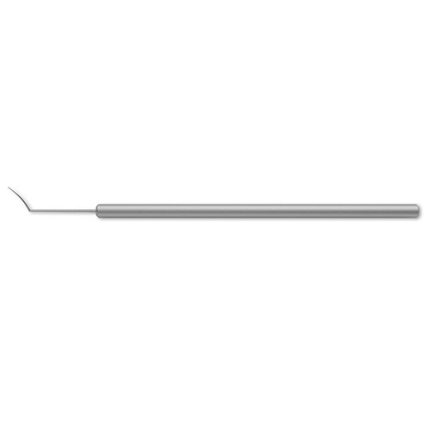Barraquer Cilia Forceps
angled, smooth jaws, 10.0 mm tying platform, 3-1/8" (8.0 cm) Barraquer Cilia Forceps are an ideal tool for ophthalmologic procedures involving the eyelid. The forceps feature slightly curved jaws with smooth tips to provide a good grasp of the cilia for blepharoplasty or management of blepharitis marginalis. The flat serrated handle gives the surgeon increased control and maneuverability.
Barraquer Cyclodialysis Spatula
4-3/4" (12.0 cm) Barraquer Cyclodialysis Spatula is a commonly used tool in the treatment of glaucoma. The spatula is used in the procedure to dissociate the ciliary body from the sclera. Further, the tool may be used to enlarge an incision from a sclerectomy if desired. The spatula features an angled tip for easier manipulation while minimizing surgical obstruction. Two sizes are available with the spatula depending on surgical preference.
Barraquer Eye Speculum
open wire blades Barraquer Eye Speculum is a commonly used tool in visualizing the ophthalmologic surgical field. The speculum features solid blades for more efficient spreading without chance of tissue obstruction. The variable compression of the spring allows the surgeon to adjust the degree of spreading. Both child and adult sizes are available depending on surgical need.
Barraquer Iris Scissors
delicate blunt blades, 2-1/8" (5.5 cm) Barraquer Iris Scissors are a specialized tool for ophthalmologic operations of the Iris. The unique offset handle minimizes surgical obstruction while entering the anterior chamber to access the iris. The scissors feature delicate blades specialized for handling iris tissue. Two blade sizes are available for the scissors depending on surgical preference.
Barraquer Iris Spatula
hexagonal handle, 3-1/2" (9.0 cm) Barraquer Iris Spatula is a commonly used tool in cataract surgery. The spatula is used to hold the iris in place while manipulating the lens capsule and nucleus. The spatula is commonly used to rotate the nucleus to a desired position for extraction. The spatula features an angled tip for easier manipulation while minimizing surgical obstruction. Two sizes are available with the spatula depending on surgical preference.
Barraquer Micro Needle Holder
Standard pattern, round handles, 5" (12.7 cm)
Barraquer Micro Needle Holder is handcrafted from surgical grade German stainless steel and designed with a reliable, smooth grip jaw. Designed with either a straight or curved jaw with optional lock, this instrument is often used for ophthalmic procedures. The round handles offer non-slip, comfortable control.
Barraquer Needle Holder – Delicate, 10mm Jaws
delicate, 10.0 mm jaws, round handle, 5-1/2" (13.9 cm) Barraquer needle holder is a often used tool in postoperative management of ophthalmologic surgeries. The holder may be used for suturing the conjunctiva, sclera, or extraocular muscles. This model features 10 mm jaws for use with standard or fine suturing needles. A locking mechanism is included to free the surgeon's hands as desired.
Barraquer Needle Holder – Delicate, 9mm Jaws
Barraquer needle holder is a often used tool in postoperative management of ophthalmologic surgeries. The holder may be used for suturing the conjunctiva, sclera, or extraocular muscles. This model features delicate jaws for fine or standard suturing needles, and features a locking mechanism as desired. Both straight and curved profiles are available depending on surgical preference.
Barraquer Needle Holder – Extra-Delicate
extra delicate, 9.0 mm tapered jaws, round handle, 5-1/4" (13.3 cm) Barraquer needle holder is a often used tool in postoperative management of ophthalmologic surgeries. The holder may be used for suturing the conjunctiva, sclera, or extraocular muscles. This model features extra delicate jaws for fine suturing needles, and features a locking mechanism as desired. Both straight and curved profiles are available depending on surgical preference.












